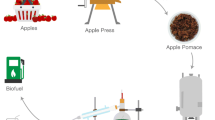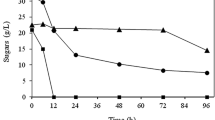Abstract
Apple pomace was studied as a possible raw material for biobutanol production. Five different soft physicochemical pretreatments (autohydrolysis, acids, alkalis, organic solvents and surfactants) were compared in a high-pressure reactor, whose working parameters (temperature, time and reagent concentration) were optimised to maximise the amount of simple sugars released and to minimise inhibitor generation. The pretreated biomass was subsequently subjected to a conventional enzymatic treatment to complete the hydrolysis. A thermal analysis (DSC) of the solid biomass indicated that lignin was mainly degraded during the enzymatic treatment. The hydrolysate obtained with the surfactant polyethylene glycol 6000 (PEG 6000) (1.96% w/w) contained less inhibitors than any other pretreatment, yet providing 42 g/L sugars at relatively mild conditions (100 °C, 5 min), and was readily fermented by Clostridium beijerinckii CECT 508 in 96 h (3.55 g/L acetone, 9.11 g/L butanol, 0.26 g/L ethanol; 0.276 gB/gS yield; 91% sugar consumption). Therefore, it is possible to optimise pretreatment conditions of lignocellulosic apple pomace to reduce inhibitor concentrations in the final hydrolysate and perform successful ABE fermentations without the need of a detoxification stage.


Similar content being viewed by others
References
Amiri H, Karimi K (2015) Autohydrolysis: a promising pretreatment for the improvement of acetone, butanol, and ethanol production from woody materials. Chem Eng Sci 137:722–729. https://doi.org/10.1016/j.ces.2015.07.020
Araque E, Parra C, Freer J, Contreras D, Rodríguez J, Mendonça R, Baeza J (2008) Evaluation of organosolv pretreatment for the conversion of Pinus radiata D. Don to ethanol. Enzyme Microb Tech 43:214–219. https://doi.org/10.1016/j.enzmictec.2007.08.006
Buruiana C-T, Vizireanu C, Garrote G, Parajó JC (2014) Optimization of corn stover biorefinery for coproduction of oligomersand second generation bioethanol using non-isothermalautohydrolysis. Ind Crop Prod 54:32–39. https://doi.org/10.1016/j.indcrop.2014.01.003
Chen J-S, Zidwick MJ, Rogers P (2013) Organic acid and solvent production: butanol, acetone and isopropanol; 1,3- and 1,2-propanediol production; and 2,3-butanediol production. In: Rosenberg E, DeLong EF, Lory S, Stackebrandt E, Thompson F (eds) The prokaryotes-applied bacteriology and biotechnology. Springer-Verlag, Heidelberg, pp 77–134
Cho DH, Lee YJ, Um Y, Sang BI, Kim YH (2009) Detoxification of model phenolic compounds in lignocellulosic hydrolysates with peroxidase for butanol production from Clostridium beijerinckii. Appl Microbiol Biot 83:1035–1043. https://doi.org/10.1007/s00253-009-1925-8
Ćosić B, Pukšec T, Krajačić G, Duić N, Markovska N, Mikulčić H, Vujanović M (2016) Database/inventory of the FRUIT AWCB value chain. AgroCycle. http://www.agrocycle.eu/documents/. Accessed in April 2017
Dhillon GS, Kaur S, Brar SK (2013) Perspective of apple processing wastes as low-cost substrates for bioproduction of high value products: a review. Renew Sust Energ Rev 27:789–805. https://doi.org/10.1016/j.rser.2013.06.046
Dien BS, Jung H-JG, Vogel KP, Casler MD, Lamb JAFS, Iten L, Mitchell RB, Sarath G (2006) Chemical composition and response to dilute-acid pretreatment and enzymatic saccharification of alfalfa, reed canarygrass, and switchgrass. Biomass Bioenergy 30:880–891. https://doi.org/10.1016/j.biombioe.2006.02.004
Díez-Antolínez R, Hijosa-Valsero M, Paniagua-García AI, Gómez X (2016) Effect of nutrient supplementation on biobutanol production from cheese whey by ABE (acetone–butanol–ethanol) fermentation. Chem Engineer Trans 49:217–222. https://doi.org/10.3303/CET1649037
Ezeji T, Qureshi N, Blaschek HP (2007) Butanol production from agricultural residues: impact of degradation products on Clostridium beijerinckii growth and butanol fermentation. Biotechnol Bioeng 97:1460–1469. https://doi.org/10.1002/bit.21373
FAOSTAT (2016) Statistics of the food and agriculture organisation of the United Nations, http://www.fao.org/faostat/en/#data (Last accessed in March 2017)
Folin O, Denis W (1912) On phosphotungstic-phosphomolybdic compounds as color reagents. J Biol Chem 12:239–243
Gama R, van Dyk JS, Pletschke BI (2015) Optimisation of enzymatic hydrolysis of apple pomace for production of biofuel and biorefinery chemicals using commercial enzymes. 3 Biotech 5:1075–1087. https://doi.org/10.1007/s13205-015-0312-7
Gao K, Rehman L (2014) ABE fermentation from enzymatic hydrolysate of NaOH-pretreated corncobs. Biomass Bioenergy 66:110–115. https://doi.org/10.1016/j.biombioe.2014.03.002
Garrote G, Domínguez H, Parajó JC (1999) Mild autohydrolysis: an environmentally friendly technology for xylooligosaccharide production from wood. J Chem Technol Biot 74:1101–1109. https://doi.org/10.1002/(SICI)1097-4660(199911)74:11<1101::AID-JCTB146>3.0.CO;2-M
Gonçalves FA, Ruiz HA, dos Santos ES, Teixeira JA, de Macedo GR (2015) Bioethanol production from coconuts and cactus pretreated by autohydrolysis. Ind Crop Prod 77:1–12. https://doi.org/10.1016/j.indcrop.2015.06.041
Guilherme AA, Dantas PVF, Santos ES, Fernandes FAN, Macedo GR (2015) Evaluation of composition, characterization and enzymatic hydrolysis of pretreated sugar cane bagasse. Braz J Chem Eng 32:23–33. https://doi.org/10.1590/0104–6632.20150321s00003146
Hirata T, Nishimoto T (1991) DSC, DTA, and TG of cellulose untreated and treated with flame-retardants. Thermochim Acta 193:99–106. https://doi.org/10.1016/0040-6031(91)80177-K
He F, Yi W, Bai X (2006) Investigation on caloric requirement of biomass pyrolysis using TG–DSC analyzer. Energ Convers Manage 47:2461–2469. https://doi.org/10.1016/j.enconman.2005.11.011
Kim BH, Bellows P, Datta R, Zeikus JG (1984) Control of carbon and electron flow in Clostridium acetobutylicum fementations: utilization of carbon monoxide to inhibit hydrogen production and to enhance butanol yields. Appl Environ Microbiol 48:764–770
Jang Y-S, Malaviya A, Cho C, Lee J, Lee SY (2012) Butanol production from renewable biomass by Clostridia. Bioresour Technol 123:653–663. https://doi.org/10.1016/j.biortech.2012.07.104
Jesse TW, Ezeji TC, Qureshi N, Blaschek HP (2002) Production of butanol from starch-based waste packing peanuts and agricultural waste. J Ind Microbiol Biot 29:117–123. https://doi.org/10.1038/sj.jim.7000285
Jones DT, Woods DR (1986) Acetone-butanol fermentation revisited. Microbiol Rev 50:484–524
Jurgens G, Survase S, Berezina O, Sklavounos E, Linnekoski J, Kurkijärvi A, Väkevä M, van Heiningen A, Granström T (2012) Butanol production from lignocellulosics. Biotechnol Lett 34:1415–1434. https://doi.org/10.1007/s10529-012-0926-3
Kapu NUS, Manning M, Hurley TB, Voigt J, Cosgrove DJ, Romaine CP (2012) Surfactant-assisted pretreatment and enzymatic hydrolysis of spent mushroom compost for the production of sugars. Bioresour Technol 114:399–405. https://doi.org/10.1016/j.biortech.2012.02.139
Kótai L, Szépvölgyi J, Szilágyi M, Zhibin L, Baiquan C, Sharma V, Sharma PK (2013) Biobutanol from renewable agricultural and lignocellulose resources and its perspectives as alternative of liquid fuels. In: Fang Z (ed) Liquid. Gaseous and Solid Biofuels-Conversion Techniques. InTech, Rijeka, pp 199–262
Kudahettige-Nilsson RL, Helmerius J, Nilsson RT, Sjöblom M, Hodge DB, Rova U (2015) Biobutanol production by Clostridium acetobutylicum using xylose recovered from birch Kraft black liquor. Bioresour Technol 176:71–79. https://doi.org/10.1016/j.biortech.2014.11.012
Kurabi A, Berlin A, Gilkes N, Kilburn D, Bura R, Robinson J, Markov A, Skomarovsky A, Gusakov A, Okunev O, Sinitsyn A, Gregg D, Xie D, Saddler J (2005) Enzymatic hydrolysis of steam-exploded and ethanol organosolv-pretreated Douglas-fir by novel and commercial fungal cellulases. Appl Biochem Biotech 121-124:219–230. https://doi.org/10.1385/ABAB:121:1-3:0219
Lee JM, Shi J, Venditti RA, Jameel H (2009) Autohydrolysis pretreatment of Coastal Bermuda grass for increased enzyme hydrolysis. Bioresour Technol 100:6434–6441. https://doi.org/10.1016/j.biortech.2008.12.068
Lloyd TA, Wyman CE (2005) Combined sugar yields for dilute sulfuric acid pretreatment of corn stover followed by enzymatic hydrolysis of the remaining solids. Bioresour Technol 96:1967–1977. https://doi.org/10.1016/j.biortech.2005.01.011
Maiti S, Sarma SJ, Brar SK, Le Bihan Y, Drogui P, Buelna G, Verma M (2016) Agro-industrial wastes as feedstock for sustainable bio-production of butanol by Clostridium beijerinckii. Food Bioprod Process 98:217–226. https://doi.org/10.1016/j.fbp.2016.01.002
Mesa L, González E, Cara C, González M, Castro E, Mussatto SI (2011) The effect of organosolv pretreatment variables on enzymatic hydrolysis of sugarcane bagasse. Chem Eng J 168:1157–1162. https://doi.org/10.1016/j.cej.2011.02.003
NREL (2008) Determination of ash in biomass. Laboratory Analytical Procedure (LAP). Technical Report NREL/TP-510-42622. http://www.nrel.gov/docs/gen/fy08/42622.pdf, accessed in May 2017
NREL (2012) Determination of structural carbohydrates and lignin in biomass. Laboratory Analytical Procedure (LAP). Technical report NREL/TP-510-42618 http://www.nrel.gov/docs/gen/fy13/42618.pdf, Accessed in May 2017
Obama P, Ricochon G, Muniglia L, Brosse N (2012) Combination of enzymatic hydrolysis and ethanol organosolv pretreatments: effect on lignin structures, delignification yields and cellulose-to-glucose conversion. Bioresour Technol 112:156–163. https://doi.org/10.1016/j.biortech.2012.02.080
Orozco AM, Al-Muhtaseb AH, Rooney D, Walker GM, Ahmad MNM (2013) Hydrolysis characteristics and kinetics of waste hay biomass as a potential energy crop for fermentable sugars production using autoclave Parr reactor system. Ind Crop Prod 44:1–10. https://doi.org/10.1016/j.indcrop.2012.10.018
Paniagua-García AI, Díez-Antolínez R, Sánchez-Morán ME, Coca-Sanz M, Hijosa-Valsero M (in preparation) Butanol production from dilute sulfuric acid hydrolysate of switchgrass by Clostridium beijerinckii: Effect of inhibitors and sugars concentration
Qureshi N, Saha BC, Hector RE, Dien B, Hughes S, Liu S, Iten L, Bowman MJ, Sarath G, Cotta MA (2010) Production of butanol (a biofuel) from agricultural residues: part II—use of corn stover and switchgrass hydrolysates. Biomass Bioenergy 34:566–571. https://doi.org/10.1016/j.biombioe.2009.12.023
Salehi Jouzani G, Taherzadeh MJ (2015) Advances in consolidated bioprocessing systems for bioethanol and butanol production from biomass: a comprehensive review. Biofuel Res J 5:152–195. 10.18331/BRJ2015.2.1.4
Sudha ML, Baskaran V, Leelavathi K (2007) Apple pomace as a source of dietary fiber and polyphenols and its effect on the rheological characteristics and cake making. Food Chem 104:686–692. https://doi.org/10.1016/j.foodchem.2006.12.016
Sun Y, Jin Y, Gao X, Li X, Xiao Y, Yao Z (2010) Effects of byproducts from acid hydrolysis of lignocelluloses on butanol fermentation by Clostridium acetobutylicum CICC8012. Chinese J Appl Environ Biol 16(6):845–850. https://doi.org/10.3724/SP.J.1145.2010.00845
Tahir A, Sarwar S (2012) Effect of cultural condition on production of ethanol from rotten apple waste by Saccharomyces cerevisiae straining. Can J App Sci 2:187–195
Várhegyi G, Antal MJ Jr, Jakab E, Szabó P (1997) Kinetic modeling of biomass pyrolysis. J Anal Appl Pyrol 42:73–87. https://doi.org/10.1016/S0165-2370(96)00971-0
Voget CE, Mignone CF, Ertola RJ (1985) Butanol production from apple pomace. Biotechnol Lett 7:43–46. https://doi.org/10.1007/BF01032418
Wei L, Shrestha A, Tu M, Adhikari S (2011) Effects of surfactant on biochemical and hydrothermal conversion of softwood hemicellulose to ethanol and furan derivatives. Process Biochem 46:1785–1792. https://doi.org/10.1016/j.procbio.2011.06.001
Xu YP, Simon JE, Welch C, Wightman JD, Ferruzzi MG, Ho L (2011) Survey of polyphenol constituents in grapes and grape-derived products. J Agr Food Chem 59:10586–10593. https://doi.org/10.1021/jf202438d
Yang H, Yan R, Chen H, Lee DH, Zheng C (2007) Characteristics of hemicellulose, cellulose and lignin pyrolysis. Fuel 86:1781–1788. https://doi.org/10.1016/j.fuel.2006.12.013
Yerushalmi L, Volesky B, Leung WK, Neufeld RJ (1983) Variations of solvent yield in acetone-butanol fermentation. Eur J Appl Microbiol Biotechnol 18:279–286. https://doi.org/10.1007/BF00500492
Zhang Y, Han B, Ezeji TC (2012) Biotransformation of furfural and 5-hydroxymethyl furfural (HMF) by Clostridium acetobutylicum ATCC 824 during butanol fermentation. New Biotechnol 29:345–351. https://doi.org/10.1016/j.nbt.2011.09.001
Zverlov VV, Berezina O, Velikodvorskaya GA, Schwarz WH (2006) Bacterial acetone and butanol production by industrial fermentation in the Soviet Union: use of hydrolyzed agricultural waste for biorefinery. Appl Microbiol Biot 71:587–597. https://doi.org/10.1007/s00253-006-0445-z
Acknowledgements
The authors thank Novozymes for kindly providing samples of their enzymes. Authors thank R. Antón del Río, N. del Castillo Ferreras and G. Sarmiento Martínez for their technical help.
Funding
The present work has been performed as part of the H2020-LCE-2015 Waste2Fuels project (sustainable production of next-generation biofuels from waste streams—Waste2Fuels; GA—654623), funded by the European Union’s Horizon 2020 Research and Innovation Programme. MH-V is supported by a postdoctoral contract (DOC-INIA, grant number DOC 2013-010) funded by the Spanish Agricultural and Agrifood Research Institute (INIA) and the European Social Fund.
Author information
Authors and Affiliations
Corresponding author
Ethics declarations
Conflict of interest
The authors declare that they have no conflict of interest.
Ethical approval
This article does not contain any studies with human participants or animals performed by any of the authors.
Electronic supplementary material
ESM 1
(PDF 101 kb)
Rights and permissions
About this article
Cite this article
Hijosa-Valsero, M., Paniagua-García, A.I. & Díez-Antolínez, R. Biobutanol production from apple pomace: the importance of pretreatment methods on the fermentability of lignocellulosic agro-food wastes. Appl Microbiol Biotechnol 101, 8041–8052 (2017). https://doi.org/10.1007/s00253-017-8522-z
Received:
Revised:
Accepted:
Published:
Issue Date:
DOI: https://doi.org/10.1007/s00253-017-8522-z




